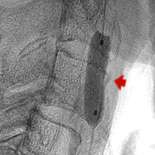Balloon Test Occlusion
Find your care
Our interventional neuroradiology team has paved the way for interventional procedures, creating several of the devices and techniques widely used today. Call 310-267-8761 to learn more about our services.
Balloon Test Occlusion at UCLA
What is a Balloon Test Occlusion?
Sometimes, it may be necessary to block off a blood vessel as the primary means of treating a problem. If that blood vessel supplies the brain, doing so might result in a stroke. However, at the base of the brain, there can be connecting vessels which can take over the blood supply. Because we are not certain, in some patients, that these connections are sufficient, we do a test beforehand. This testing involves temporarily blocking off the blood flow in the vessel we are interested in permanently blocking.
When is this procedure used and how does it work?

We do this with a small, soft balloon placed in the artery. With the balloon in place and inflated, we can then perform a neurological examination on the patient to make sure there is no problem. If the blood flow is insufficient, the patient will start to develop neurological impairment, such as weakness, loss of sensation, speech problems, etc.
When this happens, the balloon is deflated to restore the normal blood flow. Depending upon these results, we can then decide on the most appropriate course of therapy.